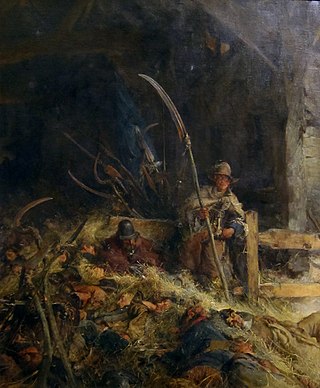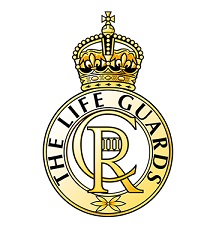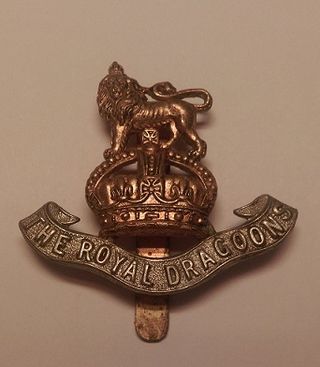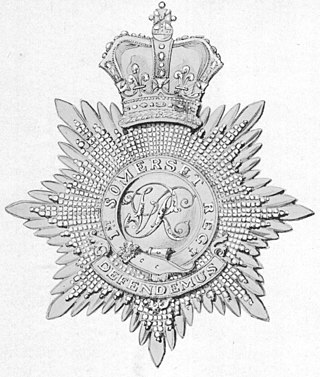
The Battle of Sedgemoor was the last and decisive engagement between the Kingdom of England and rebels led by the Duke of Monmouth during the Monmouth rebellion, fought on 6 July 1685, and took place at Westonzoyland near Bridgwater in Somerset, England, resulting in a victory for the English army.

The Monmouth Rebellion, also known as the Pitchfork Rebellion, the Revolt of the West or the West Country rebellion, was an attempt to depose James II, who in February 1685 succeeded his brother Charles II as king of England, Scotland and Ireland. A group of dissident Protestants led by James Scott, 1st Duke of Monmouth, eldest illegitimate son of Charles II, opposed James largely due to his Catholicism.

TheLife Guards (LG) is the most senior regiment of the British Army and part of the Household Cavalry, along with The Blues and Royals.

The Somerset Light Infantry (Prince Albert's) was a light infantry regiment of the British Army, which served under various titles from 1685 to 1959. In 1959, the regiment was amalgamated with the Duke of Cornwall's Light Infantry to form the Somerset and Cornwall Light Infantry which was again amalgamated, in 1968, with the King's Own Yorkshire Light Infantry, the King's Shropshire Light Infantry and the Durham Light Infantry to form The Light Infantry. In 2007, however, The Light Infantry was amalgamated further with the Devonshire and Dorset Regiment, the Royal Gloucestershire, Berkshire and Wiltshire Regiment and the Royal Green Jackets to form The Rifles.

The Devonshire Regiment was a line infantry regiment of the British Army that served under various titles and served in many wars and conflicts from 1685 to 1958, such as the Second Boer War, the First World War and the Second World War. In 1958 the regiment was amalgamated with the Dorset Regiment to form the Devonshire and Dorset Regiment which, in 2007, was amalgamated with the Royal Gloucestershire, Berkshire and Wiltshire Regiment, the Royal Green Jackets and The Light Infantry to form a new large regiment, The Rifles.

The Royal Dragoons was a heavy cavalry regiment of the British Army. The regiment was formed in 1661 as the Tangier Horse. It served for three centuries and was in action during the First and the Second World Wars. It was amalgamated with the Royal Horse Guards to form The Blues and Royals in 1969.
The Battle of Cowan's Ford took place in the Southern Theater of Cornwallis's 1780–1782 Campaign during the American Revolutionary War. It was fought on February 1, 1781, at Cowan's ford on the Catawba River in northwestern Mecklenburg County, North Carolina, between a force of about 2,400 British and about 800 Whig militia who were attempting to slow the British advance across the river. The American general William Lee Davidson was killed in this battle.

The 3rd Dragoon Guards was a cavalry regiment in the British Army, first raised in 1685 as the Earl of Plymouth's Regiment of Horse. It was renamed as the 3rd Regiment of Dragoon Guards in 1751 and the 3rd Dragoon Guards in 1765. It saw service for two centuries, including the First World War, before being amalgamated into the 3rd/6th Dragoon Guards in 1922.
The West Suffolk Militia was an auxiliary military unit in the English county of Suffolk in East Anglia. First organised during the Seven Years' War it served on internal security and home defence duties in all of Britain's major wars. It later became a battalion of the Suffolk Regiment and supplied thousands of recruits to the fighting battalions during World War I. After 1921 the militia had only a shadowy existence until its final abolition in 1953.
The Royal Wiltshire Militia was an auxiliary regiment of the British Army from the English county of Wiltshire. From their formal organisation as Trained Bands in 1558 until their final service in the Special Reserve, the Militia regiments of the county carried out internal security and garrison duties at home and overseas in all of Britain's major wars. The Wiltshire Militia was active in suppressing Monmouth's Rebellion in 1685 and was present at the Battle of Sedgemoor. It became a battalion of the Wiltshire Regiment in 1881 and trained thousands of reservists and recruits during World War I. It maintained a shadowy existence until final disbandment in 1953.

The North Somerset Yeomanry was a part-time cavalry regiment of the British Army from 1798 to 1967. It maintained order in Somerset in the days before organised police forces, and supplied volunteers to fight in the Second Boer War. It served on the Western Front in the First World War. At the outbreak of the Second World War, it continued to operate in the mounted role and then as a specialist signals unit. Postwar it joined the Royal Armoured Corps and later became infantry. Its lineage today is maintained by 93 Squadron 39 (Skinners) Signal Regiment.

The Grenadier Guards is the most senior infantry regiment of the British Army, being at the top of the Infantry Order of Precedence. It can trace its lineage back to 1656 when Lord Wentworth's Regiment was raised in Bruges to protect the exiled Charles II. In 1665, this regiment was combined with John Russell's Regiment of Guards to form the current regiment, known as the 1st Regiment of Foot Guards. Since then, the regiment has filled both a ceremonial and protective role as well as an operational one. In 1900, the regiment provided a cadre of personnel to form the Irish Guards; while later, in 1915 it also provided the basis of the Welsh Guards upon their formation.
Henry Monckton was the fourth son of John Monckton, 1st Viscount Galway, and the younger half-brother of the more famous Robert Monckton.
The 1916 Birthday Honours were appointments by King George V to various orders and honours to reward and highlight good works by citizens of the British Empire. The appointments were made to celebrate the official birthday of The King, and were published in The London Gazette and in The Times on 3 June 1916.
The Dorset Militia was an auxiliary military force in the county of Dorsetshire in South West England. From their formal organisation as Trained Bands in 1558 until their final service as the Special Reserve, the Militia regiments of the county carried out internal security and home defence duties. They saw active service during the Second Bishops' War and the English Civil War, and played a prominent part in suppressing the Monmouth Rebellion. After being the first English militia regiment to reform in 1758, they served in home defence in all of Britain's major wars, including service in Ireland, and finally trained thousands of reinforcements during World War I. After a shadowy postwar existence they were formally disbanded in 1953.
The Gloucestershire Militia was a part-time military force in the county of Gloucestershire in the West of England. From their formal organisation as Trained Bands in 1558 until their final service as a Special Reserve unit of the Gloucestershire Regiment in World War I, the Militia regiments of the county served in home defence in all of Britain's major wars.
The Somerset Militia was an auxiliary military force in the county of Somerset in South West England. From their formal organisation as Trained Bands in 1558 until their final service as the Special Reserve, the Militia regiments of the county carried out internal security and home defence duties in all of Britain's major wars. They saw active service during the Second Bishops' War, the English Civil War, the Monmouth Rebellion and the Second Boer War, and finally trained thousands of reinforcements during World War I. After a shadowy postwar existence they were formally disbanded in 1953.

The 1st Somerset Militia was an auxiliary military unit in the county of Somerset in South West England. First organised during the Seven Years' War it served on internal security and home defence duties in all of Britain's major wars. It later became a battalion of the Somerset Light Infantry and supplied thousands of recruits to the fighting battalions during World War I. After 1921 the militia had only a shadowy existence until its final abolition in 1953.

The 2nd Somerset Militia was an auxiliary military regiment in the county of Somerset in South West England. First organised during the Seven Years' War it was reformed at the start of the French Revolutionary War and continued on internal security and home defence duties in all of Britain's major wars. It later became a battalion of the Somerset Light Infantry and served in South Africa during the Second Boer War, but was disbanded in 1908.
The Battle of Bridport was fought on June 14, 1685, at the start of the Monmouth Rebellion in the town of Bridport, in Dorset, England. The battle was a victory for the Royalist forces and the rebels were forced to march to Axminster.











